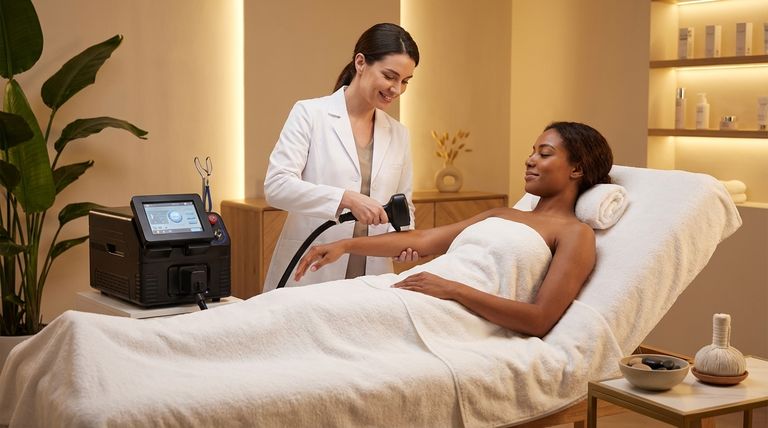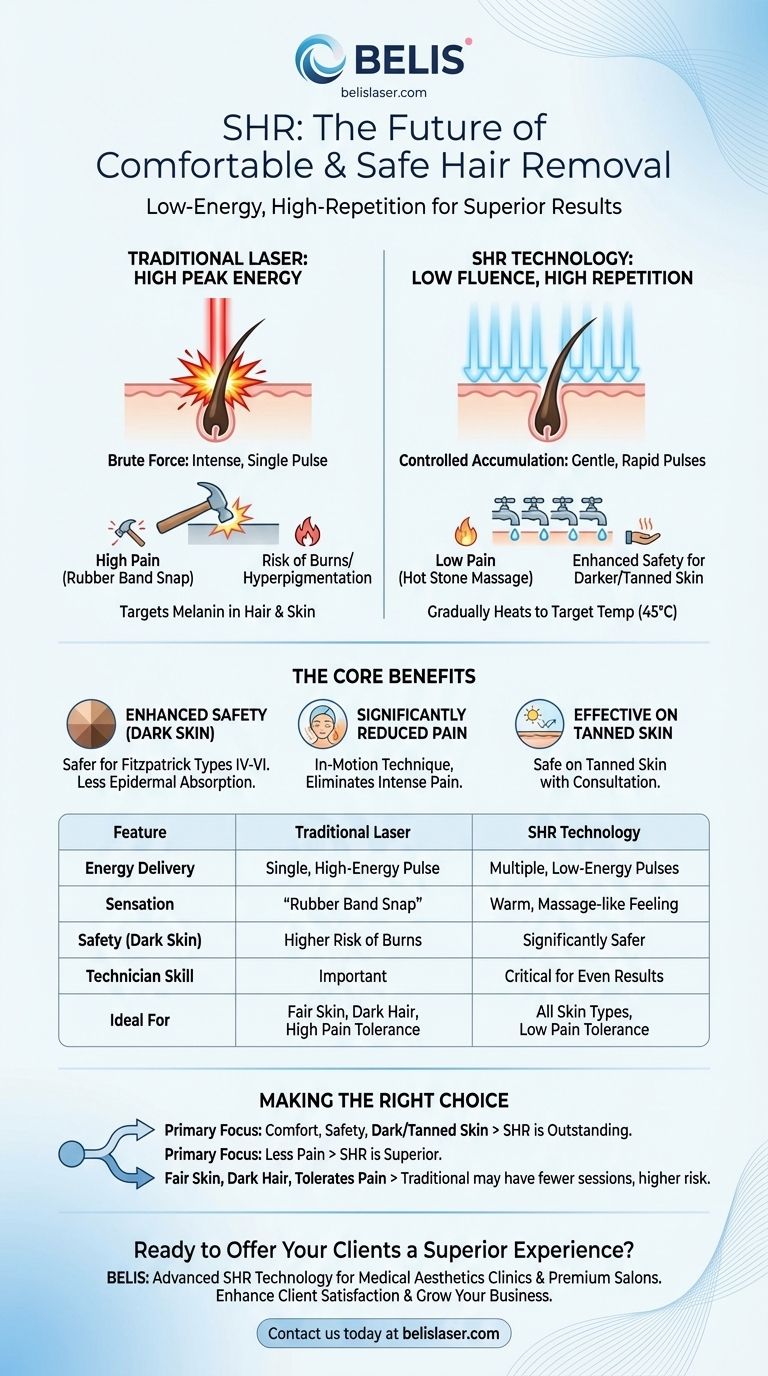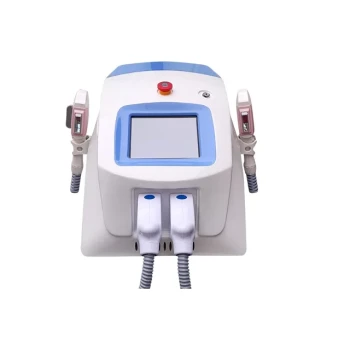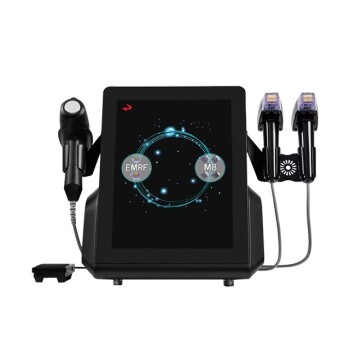At its core, SHR, or Super Hair Removal, is a technology for laser hair removal that prioritizes comfort and safety by using low-energy, rapidly repeating pulses. Instead of delivering a single, intense blast of energy to destroy the hair follicle, SHR gradually heats the skin and the follicle with multiple gentle pulses until it reaches a thermal level that damages the follicle and prevents regrowth.
The fundamental difference is in the delivery of energy. Traditional laser hair removal is like a single, powerful hammer strike, while SHR is like a series of smaller, rapid taps. Both can disable the follicle, but the SHR method does so with significantly less pain and a lower risk of skin damage.

How SHR Differs from Traditional Laser Hair Removal
To understand the value of SHR, you must first understand what it improved upon. The evolution from traditional single-pulse lasers to SHR is a shift in strategy from brute force to controlled accumulation.
The Traditional Method: High Peak Energy
Traditional lasers and Intense Pulsed Light (IPL) systems operate by delivering a single, high-energy pulse of light. This energy is absorbed by the melanin (pigment) in the hair shaft.
The energy converts to intense heat, which travels down the shaft to destroy the hair follicle. While effective, this high-energy "zap" is what causes the common "rubber band snap" sensation and carries a higher risk of burning the surrounding skin, especially in individuals with more melanin in their epidermis (darker skin tones).
The SHR Method: Low Fluence, High Repetition
SHR technology uses a principle called "low fluence," which simply means low energy. However, it delivers these low-energy pulses at a very high frequency (up to 10 times per second).
The technician keeps the handpiece in constant motion over the treatment area. This "in-motion" technique delivers numerous, overlapping pulses to the same region, gradually accumulating heat in the dermis.
Gradual Heating vs. Instant Destruction
The goal of SHR isn't to instantly char the follicle with one shot. Instead, it aims to raise the temperature of the follicle and its surrounding stem cells to a target of around 45°C.
This gentle, cumulative heating is sufficient to damage the key structures responsible for hair growth without the intense peak energy that causes pain and risks burning the skin's surface.
The Core Benefits of the SHR Approach
The unique heating method of SHR provides distinct advantages that address the primary concerns of people seeking laser hair removal: pain and safety.
Enhanced Safety for Darker Skin Tones
This is SHR's most significant contribution. Traditional lasers can be risky for darker skin (Fitzpatrick types IV-VI) because the laser can't easily distinguish between melanin in the hair and melanin in the skin.
Because SHR uses low energy and bypasses a strong reliance on melanin as the primary "target," it minimizes the risk of the epidermis absorbing too much heat. This drastically reduces the potential for burns, blistering, and hyperpigmentation.
Significantly Reduced Pain
The gradual heating process and "in-motion" delivery make the treatment far more comfortable. Most individuals describe the sensation of SHR as a feeling of warmth, similar to a hot stone massage.
This eliminates the pain and anxiety often associated with traditional laser treatments, making it a much more tolerable procedure.
Effective on Tanned Skin
For similar reasons, SHR is one of the few laser technologies that can be safely used on tanned skin. However, it is still critical to have a consultation with a qualified technician, as treatment on recently or heavily tanned skin always carries some level of risk.
Understanding the Trade-offs and Considerations
No technology is perfect for every scenario. Being an informed patient means understanding the potential downsides and knowing what questions to ask.
The Importance of Technician Skill
The "in-motion" technique is highly dependent on the operator. An unskilled or rushed technician may move the handpiece too quickly or fail to ensure adequate, overlapping coverage.
This can result in "striping" or patches of missed hair, leading to uneven results. You are paying for both the technology and the technician's expertise in using it correctly.
Number of Sessions Required
While highly effective, the lower-energy approach of SHR may sometimes require more sessions to achieve the same level of permanent hair reduction as a very high-powered, traditional laser on an ideal candidate (fair skin, dark hair).
The trade-off is clear: you exchange a degree of aggressive power for a massive gain in safety and comfort.
"SHR" as a Marketing Term
Many different manufacturers have developed their own version of this low-fluence, high-repetition technology. While "SHR" is the most common name, you may see it marketed under other brand-specific terms.
The key is to ask about the technique: Is it a single, high-energy pulse, or is it a low-energy, in-motion method?
Making the Right Choice for Your Goal
Your choice of hair removal technology should align with your skin type, pain tolerance, and primary goals.
- If your primary focus is comfort and safety, especially with darker or tanned skin: SHR is an outstanding choice due to its gentle, gradual heating method that minimizes risk to the epidermis.
- If you have very fair skin and dark, coarse hair and can tolerate discomfort: A traditional, high-powered single-pulse laser may achieve results in slightly fewer sessions, but the risk and pain are higher.
- If your primary concern is pain: SHR is almost certainly the superior option, as the "hot stone massage" sensation is far more tolerable than the "rubber band snap" of older technologies.
Understanding the underlying technology empowers you to ask the right questions and select a treatment that aligns perfectly with your needs for safety, comfort, and effectiveness.
Summary Table:
| Feature | Traditional Laser | SHR Technology |
|---|---|---|
| Energy Delivery | Single, high-energy pulse | Multiple, low-energy pulses |
| Sensation | "Rubber band snap" | Warm, massage-like feeling |
| Safety for Dark Skin | Higher risk of burns | Significantly safer |
| Technician Skill | Important | Critical for even results |
| Ideal For | Fair skin, dark hair, high pain tolerance | All skin types, especially darker/tanned skin, low pain tolerance |
Ready to Offer Your Clients a Superior Hair Removal Experience?
BELIS specializes in professional medical aesthetic equipment, providing advanced SHR technology to medical aesthetics clinics and premium beauty salons. Empower your practice with our safe, effective, and comfortable hair removal solutions that enhance client satisfaction and grow your business.
Contact us today to learn how BELIS can elevate your services!
Visual Guide

Related Products
- Diode Laser SHR Trilaser Hair Removal Machine for Clinic Use
- Clinic Diode Laser Hair Removal Machine with SHR and Trilaser Technology
- Trilaser Diode Hair Removal Machine for Beauty Clinic Use
- Diode Tri Laser Hair Removal Machine for Clinic Use
- Multifunctional Laser Hair Growth Machine Device for Hair Growth
People Also Ask
- What are the disadvantages of diode laser hair removal? Key Limitations & Safety Risks Explained
- How effective is diode laser hair removal? Achieve Long-Term Hair Reduction Safely
- Can diode laser remove hair permanently? Achieve Long-Term Hair Reduction with Precision Technology
- Is diode laser effective for hair removal? Achieve Long-Term Hair Reduction with Gold Standard Tech
- Does diode laser remove hair permanently? Understanding Permanent Hair Reduction



















